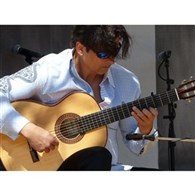Welcome to one of the most active flamenco sites on the Internet. Guests can read most posts but if you want to participate click here to register.
This site is dedicated to the memory of Paco de Lucía, Ron Mitchell, Guy Williams, Linda Elvira, Philip John Lee, Craig Eros, Ben Woods, David Serva and Tom Blackshear who went ahead of us.
We receive 12,200 visitors a month from 200 countries and 1.7 million page impressions a year. To advertise on this site please contact us.
|

|
|
What and where is the border of classical and flamenco ???
|
You are logged in as Guest
|
|
Users viewing this topic: none
|
|
Login  | |
|

   
Richard Jernigan
Posts: 3430
Joined: Jan. 20 2004
From: Austin, Texas USA

|
 RE: What and where is the border of ... (in reply to kitarist) RE: What and where is the border of ... (in reply to kitarist)
|
|
|
The border between the City of Austin where I live, and the adjacent City of Round Rock is perfectly clear, accurately surveyed and posted. This is important, because it determines to whom we pay taxes, and which laws we must obey.
The border between Central Texas and South Texas is much more diffuse and indistinct. Culturally it is somewhere south of New Braunfels. North of this "border" the culture is distinctively "Anglo": English speaking strongly influenced by a long history of white settlement. San Antonio was founded by the Spanish, was an important Mexican town before Texas independence, and is now at least 60% Latino ethnically.
On the other hand, the Balcones fault and the Edwards Plateau to the west of it are important geological features of both San Antonio and Austin. South of San Antonio, you are south of these features. Where you draw the border depends upon the criteria used to judge it, and has a much smaller practical effect than political borders.
The border between classical and flamenco is a cultural one. Carulli and Sor are classical, Niño Ricardo and Paco de Lucia are flamenco. Where you draw the border depends upon which criteria you use.
Arcas's Soleá doesn't conform exactly to the prevailing modern flamenco definition due to differences in compás, key signature and guitar tuning. We really don't know exactly how soleá was defined by flamencos at the time (no later than 1867) when Arcas wrote his piece. Nor can you draw a precise line between 20th century "old school" and "new style" soleá.
RNJ
|
|
|
|
REPORT THIS POST AS INAPPROPRIATE |
Date Oct. 20 2019 21:48:20
 |
|

   
devilhand
Posts: 1598
Joined: Oct. 15 2019

|
 RE: What and where is the border of ... (in reply to docco) RE: What and where is the border of ... (in reply to docco)
|
|
|
quote:
The technique, the way to perform music, can not be considered as a character of the music. Therefore, it can not be used to distinguish a genre of music to others, such as flamenco vs classical music.
What I want to pay attention to is their harmony.
Rhythm is the most important feature that makes a certain type of music distinguishable to others. This is definitely not the case with harmony. For example, the same 7th chord can be played in different music styles. On the other hand, you cannot play, let's say a shuffle rhythm, in flamenco or reggae or funk.
As for technique, it's true to some degree because technique is just a tool. However, you cannot produce flamenco sound for example picado or alzapua with classical guitar technique. You will not sound flamenco.
Classical music uses complex harmony comparing to flamenco or pop/rock music. But this complexity lies in the rate of change in the harmony. That means in classical music harmony changes at a irregular rate and a bunch of chords are played in one measure. But harmony itself cannot be the feature that distinguishes classical music from flamenco.
|
|
|
|
REPORT THIS POST AS INAPPROPRIATE |
Date Oct. 22 2019 15:58:39
 |
|

   
kitarist
Posts: 1715
Joined: Dec. 4 2012

|
 RE: What and where is the border of ... (in reply to docco) RE: What and where is the border of ... (in reply to docco)
|
|
|
quote:
ORIGINAL: docco
quote:
ORIGINAL: Piwin
quote:
The technique, the way to perform music, can not be considered as a character of the music
Why not?
For example, Latin music has rhythm with clave but we can not say Latin music is distinguished with the clave, but we can say that Latin music is distinguished by multi-rhythm and syncopation, and clave is only the tool to perform these characteristics.
Well, you are just moving up categorically to the musical elements the particular distinguishing characteristics belong to. To do the same with rasgueado (by which is meant not the technique, but its musical outcome), we can then say flamenco is chiefly distinguished by particular tone colours and textures (such as that of rasgueado, and I would add golpe, alzapua). Also, possible examples of distinguishing harmonic characteristics would be the Andalusian cadence and the frequent use of a phrygian tonality.
_____________________________
Konstantin
|
|
|
|
REPORT THIS POST AS INAPPROPRIATE |
Date Oct. 22 2019 18:32:17
 |
|

   
BarkellWH
Posts: 3458
Joined: Jul. 12 2009
From: Washington, DC

|
 RE: What and where is the border of ... (in reply to docco) RE: What and where is the border of ... (in reply to docco)
|
|
|
The question of what and where is the border between classical and flamenco assumes that each genre has rigidly defined characteristics with a well-defined border separating them. While there are certain characteristics that can be ascribed to each, I think, and many comments here seem to suggest, that an absolute definition cannot answer the question.
It brings to mind the 1964 opinion by United States Supreme Court Justice Potter Stewart to describe his threshold test for obscenity in Jacobellis v. Ohio. In explaining why the material at issue in the case was not obscene under the Roth test, and therefore was protected speech that could not be censored, Stewart wrote: "I shall not today attempt further to define the kinds of material I understand to be embraced within that shorthand description ["hard-core pornography"], and perhaps I could never succeed in intelligibly doing so. But I know it when I see it, and the material at issue is not that."
Perhaps that is the best we can hope to accomplish in attempting to answer the question posed by this thread.
Bill
_____________________________
And the end of the fight is a tombstone white,
With the name of the late deceased,
And the epitaph drear, "A fool lies here,
Who tried to hustle the East."
--Rudyard Kipling
|
|
|
|
REPORT THIS POST AS INAPPROPRIATE |
Date Oct. 23 2019 5:43:25
 |
|

   
Richard Jernigan
Posts: 3430
Joined: Jan. 20 2004
From: Austin, Texas USA

|
 RE: What and where is the border of ... (in reply to etta) RE: What and where is the border of ... (in reply to etta)
|
|
|
quote:
ORIGINAL: etta
Interesting stuff Ricardo. But, it seems to me that you cannot have flamenco in any practical, accepted form without a flamenco guitar.
I've been interested in flamenco for quite a while. I still play guitar daily except Sunday. About half the time it's flamenco, the rest classical, often on alternating days. It's an important part of my life.
But I can't remember the last time I listened to a solo flamenco guitar album. If I put on a CD to listen, it's cante. Yes, there is usually guitar accompaniment, but there's plenty of cante a palo seco. I think martinete, debla, etc. are unquestionably flamenco.
But maybe they are not practical or accepted?
Last month we went to Tablao Cordobés in Barcelona. The place was full. The show was almost entirely baile, very professional and polished. Paloma Fantova started off with a beautiful slow soleá. The rest was fast and loud. Very fast and very loud. There was guitar accompaniment, but you could hardly hear it over the taconeo.
The audience were mainly foreign tourists like us. There was one young woman seated near us who seemed conscious of the compas. I thought maybe she was a young dancer, who came to see the money making pros. Each impressive athletic display got an enthusiastic round of applause from the packed house.
There was one guitar piece by David Cerreduela, Tuto and Eugenio Santiago, who otherwise provided dance accompaniment. The main objectives of the guitar piece, with "modern" harmony and syncopated compas, seemed to be to get in as many notes as possible, as rapidly as possible. I found it boring. But I suppose it was flamenco. And it was practical and accepted: it got a big round of applause.
RNJ
|
|
|
|
REPORT THIS POST AS INAPPROPRIATE |
Date Oct. 24 2019 18:44:22
 |
|

   
Richard Jernigan
Posts: 3430
Joined: Jan. 20 2004
From: Austin, Texas USA

|
 RE: What and where is the border of ... (in reply to Paul Magnussen) RE: What and where is the border of ... (in reply to Paul Magnussen)
|
|
|
quote:
ORIGINAL: Paul Magnussen
I imagine that, being unaccompanied, they’re simply too hard-core for many casual aficionados.
Yes. In some respects I have gotten old and set in my ways, though I generally find younger people more congenial than many of my contemporaries.
The first LP I bought, at age 12, was Toscanini and the NBC Symphony playing Beethoven's Eroica Symphony. One of the few times I have heard it since, when I did not automatically compare the performance with Toscanini's, was when the Austin Symphony played it last year. Listening from one of my favorite seats in the hall, I was carried away by the "stereophonic" effect of Beethoven's magnificent orchestration. Musical figures were taken up in turn from different instruments in different places. Not a novel experience, but it had a novel effect on me.
RNJ
|
|
|
|
REPORT THIS POST AS INAPPROPRIATE |
Date Oct. 24 2019 19:18:46
 |
|
 New Messages New Messages |
 No New Messages No New Messages |
 Hot Topic w/ New Messages Hot Topic w/ New Messages |
 Hot Topic w/o New Messages Hot Topic w/o New Messages |
 Locked w/ New Messages Locked w/ New Messages |
 Locked w/o New Messages Locked w/o New Messages |
|
 Post New Thread
Post New Thread
 Reply to Message
Reply to Message
 Post New Poll
Post New Poll
 Submit Vote
Submit Vote
 Delete My Own Post
Delete My Own Post
 Delete My Own Thread
Delete My Own Thread
 Rate Posts
Rate Posts
|
|
|
Forum Software powered by ASP Playground Advanced Edition 2.0.5
Copyright © 2000 - 2003 ASPPlayground.NET |
0.09375 secs.
|


 Printable Version
Printable Version









 New Messages
New Messages No New Messages
No New Messages Hot Topic w/ New Messages
Hot Topic w/ New Messages Hot Topic w/o New Messages
Hot Topic w/o New Messages Locked w/ New Messages
Locked w/ New Messages Locked w/o New Messages
Locked w/o New Messages Post New Thread
Post New Thread